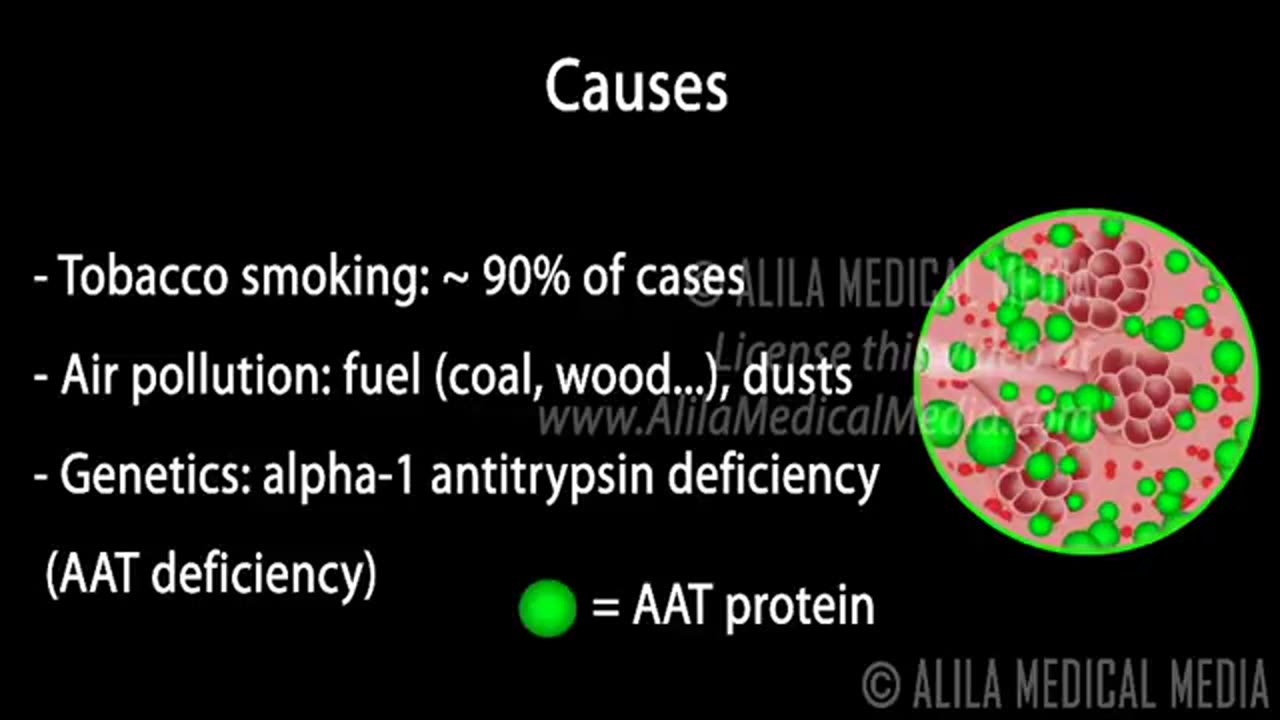Premium Only Content

COPD - Chronic Obstructive Pulmonary Disease, Animation.
Pathology, symptoms, causes, risk factors and treatments of COPD. This video is available for instant download licensing here: https://www.alilamedicalmedia.com/-/g...
Voice by: Abbie Drum
©Alila Medical Media. All rights reserved.
Support us on Patreon and get FREE downloads and other great rewards: patreon.com/AlilaMedicalMedia
All images/videos by Alila Medical Media are for information purposes ONLY and are NOT intended to replace professional medical advice, diagnosis or treatment. Always seek the advice of a qualified healthcare provider with any questions you may have regarding a medical condition.
Chronic obstructive pulmonary disease, or COPD, is a PROGRESSIVE inflammatory lung disease characterized by INCREASING breathing difficulty. Other symptoms include cough, most commonly with mucus, chest tightness and wheezing. COPD develops as a result of LONG-TERM exposure to irritants such as smoke, chemical fumes or dusts, and may go UNNOTICED for years. Most people show symptoms after the age of 40 when the disease is already in its advanced stage.
The lungs consist of millions of air tubes or airways, called bronchi and bronchioles, which bring air in and out of the body. These airways end with tiny air sacs - the alveoli - where the gas exchange process takes place. REPEATED inhalation of irritants results in a CHRONIC inflammatory response which brings in a large amount of defensive cells along with inflammatory chemicals from the immune system. Inflammation of the airways causes them to thicken and produce mucus, NARROWING the air passage – this is known as CHRONIC BRONCHITIS. Inflammatory chemicals also dissolve alveolar walls, resulting in DESTRUCTION of the air sacs – this is EMPHYSEMA. COPD is, basically, a COMBINATION of these two conditions.
Tobacco smoking is accountable for about 90% of COPD cases. These include current, former smokers and people frequently exposed to second-hand smoke.
Extended contact with harmful chemicals such as fumes from burning fuel or dusts, at home or workplace, may also cause COPD.
Genetics has been implicated in a small number of cases. Notably, a condition known as alpha-1 antitrypsin deficiency, or AAT deficiency, has been shown to increase risks for COPD and other lung diseases. AAT protein protects the lungs from damaging effects of enzymes released during inflammation. Low levels of AAT make lung tissues more vulnerable to destruction when inflamed. While people with AAT deficiency may develop COPD even WITHOUT smoking or exposure to harmful irritants, AAT deficient smokers are at MUCH greater risks.
COPD is diagnosed based on symptoms, history of exposure to irritants and lung function tests. The major test for COPD is SPIROMETRY, in which the patient is asked to blow into a tube connected to a machine – a spirometer. Spirometry evaluates pulmonary functions by measuring the volume and the speed of air flow during inhalation and exhalation.
There is no cure for COPD but treatments can relieve symptoms, prevent complications and slow down progression of the disease. The first and most essential step to treatment is to stop smoking and/or improve air quality at home and workplace. These are also the most effective measures in preventing the disease.
Other treatments include:
-Medication: bronchodilators are used to widen the airways; steroids to relieve inflammation.
-Vaccination against flu and pneumococcal pneumonia: this is to prevent serious complications COPD patients may have with these respiratory infections.
-Supplemental oxygen: this can improve quality of life provided that the patient no longer smokes.
-Breathing exercises and other therapies as part of a pulmonary rehabilitation program.
-Finally, surgery may be performed for severe cases when other methods fail. Surgical procedures include bullectomy, lung volume reduction surgery, where damaged parts of the lung are removed; and lung transplant, where the entire diseased lung is replaced with a healthy lung from a deceased donor.
-
 18:37
18:37
Clownfish TV
11 hours agoThe Oscars Just EMBARASSED Disney and Emilia Pérez...
78.1K23 -
 56:28
56:28
Glenn Greenwald
13 hours agoDocumentary Exposing Repression in West Bank Wins at Oscars; Free Speech Lawyer Jenin Younes on Double Standards for Israel's Critics | SYSTEM UPDATE #416
121K99 -
 1:03:34
1:03:34
Donald Trump Jr.
15 hours agoZelensky Overplays His Hand, More Trump Wins, Plus Interview with Joe Bastardi | Triggered Ep.221
190K145 -
 1:13:16
1:13:16
We Like Shooting
23 hours ago $7.41 earnedDouble Tap 399 (Gun Podcast)
69.7K2 -
 1:00:20
1:00:20
The Tom Renz Show
1 day agoTrump Schools Zelensky, The Epstein Files FAIL, & What RFK Will Mean for Cancer
80.9K25 -
 42:47
42:47
Kimberly Guilfoyle
16 hours agoThe Trump effect: More Major Investment, Plus America First at Home & Abroad. Live w/Ned Ryun & Brett Tolman | Ep. 201
155K40 -
 1:29:23
1:29:23
Redacted News
15 hours agoWW3 ALERT! Europe pushes for war against Russia as Trump pushes peace and cutting off Zelensky
186K306 -
 57:56
57:56
Candace Show Podcast
19 hours agoHarvey Speaks: The Project Runway Production | Ep 1
174K108 -
 56:31
56:31
LFA TV
1 day agoEurope’s Relationship With America Is Over | TRUMPET DAILY 3.3.25 7PM
56.4K11 -
 2:04:45
2:04:45
Quite Frankly
17 hours ago"European Deth Pact, Blackout Data Breach, Epstein" ft. Jason Bermas 3/3/25
54.9K24